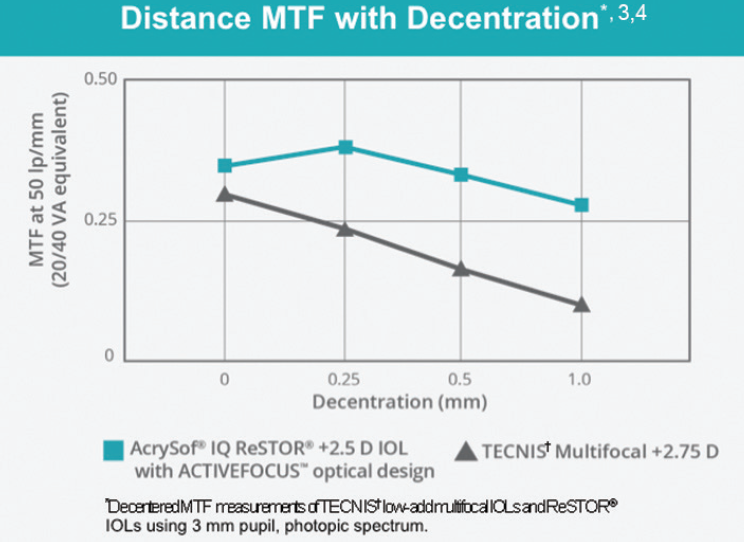When it comes to new IOL modalities, I am typically skeptical of the claims I hear and am likely considered a slow adopter. In fact, I only started offering multifocal and other presbyopia-correcting options after a number of patients came to me asking if they were candidates.
I understood that patients were looking to improve the quality of their postoperative vision, but my hesitance with previous presbyopia correcting IOLs was really twofold: they all involved a degree of compromise and there were multiple qualifiers associated with their use. I was never fully confident that my patients would be happy with the outcome nor that the available lens options were broadly applicable.
The AcrySof IQ ReSTOR +2.5 D IOL with ACTIVEFOCUS optical design (Alcon) was a game changer for me and for my practice. Because the central optical zone is targeted to distance,1,2 I sensed there would be less need to counsel patients about accepting compromises. Removing that barrier might mean it would be more user friendly from the perspective of the surgeon and staff and that it might be more acceptable to patients.
When I started using the AcrySof IQ ReSTOR+2.5 D IOL with ACTIVEFOCUS optical design, I found that it is exactly what we needed in a presbyopia correcting lens—something that keeps patients seeing sharply at distance while expanding the range of vision (Figure).3

Patients with previous LASIK surgery have historically been poor candidates for multifocal technology. On the one hand, they may have heightened expectations for their postoperative vision relative to other cataract patients. Especially if the previous refractive surgery was successful, they may also be more motivated to avoid wearing glasses.
Of all the multifocal options available, we have found that the distance dominant AcrySof IQ ReSTOR +2.5 D IOL with ACTIVEFOCUS optical design design worked equivalently to a monofocal for distance vision in post-LASIK patients.
- Having the central zone targeted to distance means it performs very much like a monofocal for distance viewing.5,6
- The lens is designed to provide excellent contrast sensitivity,1,6,7 and so patients are likely to achieve improvements in quantity and quality of vision.
- Importantly, all AcrySof IQ ReSTOR IOLs are constructed with negative spherical aberration,7 which is especially important in eyes with positive spherical aberration in the cornea due to previous myopic LASIK.
We recently studied outcomes with the AcrySof IQ ReSTOR +2.5 D IOL with ACTIVEFOCUS optical design in post-LASIK eyes and found that it performed no differently at distance compared with a monofocal lens.5 Notably, AcrySof IQ ReSTOR IOL with ACTIVEFOCUS optical design is also available in a toric model, which is a viable option for for eyes that are post-LASIK with residual astigmatism.
I use the AcrySof IQ ReSTOR IOL with ACTIVEFOCUS optical design in my practice because in my experience it is more forgiving than other types of multifocal lenses I have tried in the past. All cataract patients should be evaluated for ocular diseases and corneal issues that may compromise the outcome, and this is true for post-LASIK eyes. Because the center portion of the lens functions very much like a monofocal lens,1,6,7 I’m much more willing to use the ACTIVEFOCUS lens in patients that have some dry eye or a bit of macular change than I typically am with other types of multifocal lenses—as long as the patient is highly motivated and goes through counseling and therapuetic treatment.
1. Alcon Data on File (April 11, 2016).
2. Alcon Data on File (Oct. 17, 2016).
3. Alcon Data on File (Oct. 6, 2016).
4. Hill W. Modulation Transfer Function (MTF). East Valley Ophthalmology website. https://doctor-hill.com/patients/modulation_transfer_function.htm. Accessed Feb. 2, 2018.
5. Fisher BL, Potvin R. Clinical outcomes with distance-dominant multifocal and monofocal intraocular lenses in post-LASIK
cataract surgery planned using an intraoperative aberrometer. Clin Exp Ophthalmol. 2018;46(6):630-636.
6. AcrySof IQ ReSTOR +2.5 D IOL Directions for Use.
7. Alcon Data on File (Aug. 7, 2013).
8. 7. Vega F, Alba-Bueno F, Millán MS, Varon C, Gil MA, Buil JA. Halo and through-focus performance of four diffractive multifocal intraocular lenses. Invest Ophthalmol Vis Sci. 2015;56(6):3967-3975 (Study conducted with corneal model eye with 0.28μ spherical aberration).
AcrySof, ACTIVEFOCUS and ReSTOR are trademarks of Novartis. All other brand/product names are the trademarks of their respective owners.

